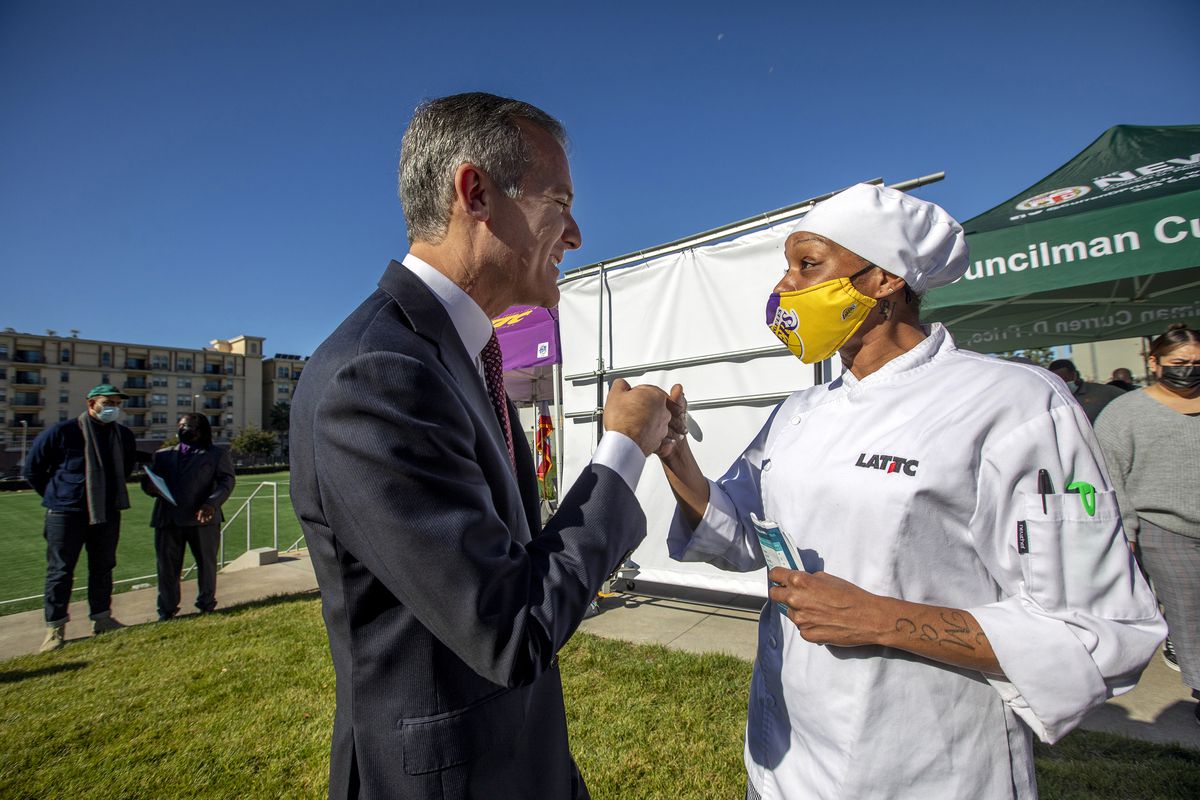At the start of the year, the Future Perfect team sat down to try to predict what was to come in 2021. It’s a little exercise we do every year to flex our forecasting muscles.
As it turns out, our predictions this year were closer to the mark than the ones we made in 2020, a year for which none of us put down “a global pandemic of unprecedented scale will break out and force billions of people into lockdown.” Whoops.
But we were hardly foolproof this year. Out of 22 predictions, we got 13 right — not bad, but still lots of room for improvement. We didn’t predict the record-fast recovery of the American economy or the Social Democrats’ victory in Germany. But we did call some important things: continued growth in India, the swift early pace of vaccination in the US, an increase in global carbon emissions.
Predicting the future is a skill at which some people are dramatically better than others, and practicing is one of the best ways to improve at it. Recording our expectations every year helps us get better at seeing what lies ahead.
Looking back at our predictions is an accountability exercise, too. Readers look to Vox because they believe we have some insight into making sense of the world. When we evaluate our predictions, we quantify where we’ve done best at seeing what lies ahead, and where we need to improve.
Here’s what we got right and wrong about the year 2021. (And check back in January when we reveal our predictions for 2022!)
The United States
Table of Contents
- 1 The United States
- 1.1 Trump will uneventfully leave office on January 20 (70 percent) — TECHNICALLY RIGHT
- 1.2 Biden will have a treasury secretary, secretary of state, defense secretary, and attorney general confirmed by the end of the year (70 percent) — RIGHT
- 1.3 At least one US state will have an abortion ban currently blocked by the courts go into effect (40 percent) — WRONG
- 1.4 No one in Trump’s immediate family will be indicted (65 percent) — RIGHT
- 1.5 Trump approval rating by year’s end will be in the 40 to 45 percent range (70 percent) — RIGHT
- 1.6 The US unemployment rate will stay above 5 percent through November (70 percent) — WRONG
- 1.7 US poverty will be higher in late 2021 than it was in late 2020 (80 percent) — WRONG
- 1.8 The median home price in the Bay Area will fall 5 percent or more (70 percent) — WRONG
- 1.9 100 million Americans will be vaccinated, at least partially, against the coronavirus by the end of April (70 percent) — RIGHT
- 1.10 Restaurant reservations and consumer spending outside the home will be back to normal by the end of the year (70 percent) — MOSTLY RIGHT
- 2 The world
- 2.1 A deadly new zoonotic outbreak will emerge (55 percent) — WRONG
- 2.2 The US will enact policies to hold China accountable for its treatment of Muslims, but the internment camps will remain open (80 percent) — RIGHT
- 2.3 The Hadi government and Houthi rebels in Yemen will reach a peace agreement (60 percent) — WRONG
- 2.4 LDP will continue to govern Japan (90 percent) and CDU will continue to govern Germany (80 percent) — RIGHT and WRONG
- 2.5 India’s economy will grow in the first three quarters of 2021 after shrinking briefly in 2020 (70 percent) — RIGHT
- 2.6 At least three new basic income pilots will be launched (75 percent) — RIGHT
- 2.7 No more countries will leave the EU (80 percent) — RIGHT
- 3 Technology and environment
- 3.1 An AI breakthrough will lead to a game-changing advance in biology (75 percent) — RIGHT
- 3.2 Global carbon emissions will increase (90 percent) — RIGHT
- 3.3 Average world temperatures will increase relative to 2020 (80 percent) — WRONG
- 3.4 Plant-based meat market share will increase by at least 20 percent (80 percent) — WRONG
Trump will uneventfully leave office on January 20 (70 percent) — TECHNICALLY RIGHT
One of the big lessons of making predictions is that you’ve got to be incredibly specific about what you mean. I was aware of that lesson when I wrote this last year, so I tried to be specific: “If the president has to be dragged by force out of the White House, or stages a protest to Biden’s inauguration on Inauguration Day, then I’ll be proven wrong,” I wrote. Those things didn’t happen.
That said, the three weeks between when we published this prediction and when Trump left office were far more eventful than I had imagined. The January 6 Capitol riot happened, an event whose aftershocks can still be felt to this day. Trump did indeed slink meekly away on January 20, but I feel that in spirit this prediction was somewhat mistaken, even if its literal letter did come true that day. —Kelsey Piper

Biden will have a treasury secretary, secretary of state, defense secretary, and attorney general confirmed by the end of the year (70 percent) — RIGHT
When we wrote these predictions, the fate of the Senate was still in the balance, with runoffs in Georgia still to come. A depressing prediction that was floating around at the time was that a Republican-controlled Senate would block everything Biden did, perhaps even something as fundamental as appointing a Cabinet.
That seemed unlikely to me even if Republicans ended up controlling the Senate — at the very least, I thought, he would get some core members of his Cabinet confirmed. I argued that I expected most GOP obstruction to be more subtle than literally blocking the appointment of, say, the secretary of state for an entire year. “Plus,” I added, “there’s a chance that Democrats win both Georgia runoffs, which look like toss-ups in the polls.”
Indeed, that’s what ended up happening, so dire predictions that Biden would be unable to govern at all didn’t have a chance to come true. —KP
At least one US state will have an abortion ban currently blocked by the courts go into effect (40 percent) — WRONG
Once again, the exact wording of these predictions ends up being important. If I’d predicted “the Supreme Court will permit a US state to implement an abortion ban that historically it would not have allowed,” that would have come true: The Supreme Court allowed Texas’s SB 8 to go into effect temporarily while it considers the legal challenge. That has drastically limited access to abortion in the state of Texas. It’s the kind of law that a Supreme Court with more moderate members would likely have blocked.
But my prediction specified that it would be one of the bans that were already law in a state but are currently blocked by the courts that would go into effect. That did not happen in 2021 — though it’s expected the Supreme Court will do so soon with Dobbs v. Jackson Women’s Health Organization. —KP
No one in Trump’s immediate family will be indicted (65 percent) — RIGHT
My reasoning for predicting that the former president, his children, and his son-in-law would avoid criminal indictment was, basically, that Democratic prosecutors would forget about their wrongdoing. “New York Attorney General Letitia James and Manhattan District Attorney Cy Vance are political actors and will notice that the voter demand for such investigations no longer exists come mid-2021,” I wrote, “And the Biden Justice Department will likely be reticent to prosecute his predecessor.”
The last part was dead-on: If anything, Attorney General Merrick Garland has been even more reticent to confront the Trump family and the Trump administration’s wrongdoing than I would have predicted. And James turned her focus to now ex-governor Andrew Cuomo rather than on Trump (though that may now be changing with Cuomo gone).

Vance stayed on the Trumps longer than I would have guessed, indicting the Trump Organization and executive Allen Weisselberg and convening a grand jury investigation with the potential to indict the former president. But Vance left office at the end of 2021 and punted the issue to his successor, Alvin Bragg. —Dylan Matthews
Trump approval rating by year’s end will be in the 40 to 45 percent range (70 percent) — RIGHT
A note: Technically, “approval ratings” are generally only polled for current presidents, so after Trump left office, pollsters changed to asking about “favorability.” They’re obviously different concepts, but for this exercise, they’re close enough, so we’ll use “favorability” as the measure here. The trend I observed at the start of the year held. Trump’s favorability, according to 538’s aggregator, has been pretty much flat all year, with just one exception: Shortly after the violent disaster at the US Capitol, opinion of the president briefly dipped to about 38 percent before rising back into its usual range.
My analysis at the time was that “it doesn’t seem likely to me that Trump will see such a bump, for the same reason that no other events have affected his approval ratings. Americans know how they feel about Trump, and at this point those feelings are barely responsive to anything Trump does.” That seems true enough! Even the events of January 6 only put a brief dent in our massive, society-wide impasse about what to think of Donald Trump. —KP
The US unemployment rate will stay above 5 percent through November (70 percent) — WRONG
By the end of 2020, we knew that the recovery from the spring’s Covid-19 induced recession was going better than the recovery from the 2008 financial crisis, with employment and GDP growth rebounding faster.
But it still took unemployment more than seven years to fall back to 5 percent after rising to that level in 2008. I thought it would at least take a couple of years to do the same this time around. Thankfully, it didn’t. Heavy monetary stimulus from the Federal Reserve and the massive American Rescue Plan passed by Congress in March propelled the fastest economic recovery of my lifetime.
The only downside is that manufacturers and oil drillers shared my pessimism, and made decisions about production that assumed a slower recovery. The result was a shortage of key consumer goods like oil, semiconductors, and cars that has contributed to this past year’s high levels of inflation. —DM
US poverty will be higher in late 2021 than it was in late 2020 (80 percent) — WRONG
I predicted that the ending of Trump-era fiscal stimulus, and a divided Congress under Joe Biden, would block more of the policies (like vastly expanded unemployment benefits and big stimulus checks) that pushed poverty in 2020 to historic lows.
I was wrong about that because I was wrong about who would win Georgia’s elections to the US Senate. I thought Biden would have a Republican Senate, and in a stroke of spectacular luck he got a Democratic one. So Biden and the Democrats passed a bill authorizing $1,400 checks, extending unemployment benefits, and enacting a (temporary) child benefit worth up to $300 per child per month.

So what did that do to poverty? Columbia’s Center on Poverty and Social Policy estimates that in November 2020, the poverty rate was 16.1 percent. In November 2021, the most recent monthly data, it was 12.7 percent. Economists Bruce Meyer, James Sullivan, and Jeehoon Han estimate that in October 2020, the rate was 11.3 percent. In November 2021, their most recent monthly data, it was 11 percent. I thought poverty would be substantially higher because Congress would fail to pass any additional cash support. That was just incorrect. —DM
The median home price in the Bay Area will fall 5 percent or more (70 percent) — WRONG
At the start of this year, it looked to me like San Francisco might actually be losing its throne as the unavoidable capital of tech, with more companies moving out of the city and more people empowered to permanently work from home. Those trends continued, but housing prices bounced back. Even a pandemic can’t make the Bay Area affordable. (We’ll see if California’s recently enacted housing bills can make a dent where Covid didn’t.) —KP
I made this prediction based on vaccine contracts and back-of-the-envelope math. Pfizer had agreed to give the US 100 million doses by the end of March, enough to offer two doses each to 50 million people. And Moderna had said it would have 85 million to 100 million doses ready for Americans in the first quarter, providing two doses each for perhaps another 50 million people. Based on that and Anthony Fauci’s statement that the US could distribute 1 million shots per day, I reasoned that Biden’s stated goal — distributing 100 million shots in his first 100 days as president — was achievable.
Happily, I was right. According to vaccination statistics from Our World in Data, by April 30, 112.77 million people were fully vaccinated, and 153.93 million had received at least one dose. —Sigal Samuel
Restaurant reservations and consumer spending outside the home will be back to normal by the end of the year (70 percent) — MOSTLY RIGHT
I specified that I’d evaluate this prediction by looking at this page of government statistics — and it shows retail and food services spending rebounding mostly to normal. As I predicted, once vaccines were widely available, many people went back to normal. That said, I didn’t anticipate how new variants would disrupt our fragile return to our pre-pandemic lives. I expect restaurants and retail spending might dip again this winter as we suffer through an omicron surge. —KP

The world
A deadly new zoonotic outbreak will emerge (55 percent) — WRONG
I predicted with fairly low confidence that we’d see the emergence of a new disease that starts in animals, spills over into humans, and causes at least a few dozen deaths. It was a reasonable guess given that 75 percent of new diseases originate in animals, and our environmental practices and factory farming system continue to make zoonotic outbreaks increasingly likely.
But I’m thrilled to say that for this year, I was wrong. Although 2021 did see a bunch of zoonotic outbreaks in the US and abroad, according to the World Health Organization none have met the criteria I’d set: new diseases that kill at least a few dozen people. —SS
The US will enact policies to hold China accountable for its treatment of Muslims, but the internment camps will remain open (80 percent) — RIGHT
In March, the US joined the EU, the UK, and Canada in imposing coordinated sanctions on senior Chinese officials over human rights violations against the Uyghurs, a predominantly Muslim minority group in China. The sanctions included travel bans and asset freezes. More recently, the Biden administration announced a diplomatic boycott of the 2022 Beijing Olympics and more sanctions on China, and the House passed the Uyghur Forced Labor Prevention Act.

But as I predicted, these moves have not been enough to induce China to close its internment camps. In fact, the Chinese government said the March sanctions were based on “lies and disinformation,” and it imposed counter-sanctions on American and European officials. The evidence, including satellite imagery, suggests the camp system is still running. —SS
The Hadi government and Houthi rebels in Yemen will reach a peace agreement (60 percent) — WRONG
When I saw that I had made this prediction, I was frankly baffled by my past self’s chutzpah. But I had my reasons. I thought that Joe Biden’s election would mark an end to US support for Saudi Arabia’s efforts to prop up the Hadi government in Yemen and that this shift would force the government to reach a deal with the Iranian-backed Houthis. I took encouragement from signals from Saudi Arabia that they were open to a ceasefire.
Shortly after taking office, Biden did announce he was ending US support for “offensive” operations in Yemen. But his support for the Saudis has continued in other ways, including arms sales for purportedly defensive weapons. Critics of the administration’s approach, like scholars Annelle Sheline and Bruce Riedel, have also faulted Biden for not calling for an end to the Saudi blockade of Yemen, an action (or inaction) that has contributed to food shortages and starvation, and amounted to an alternate form of support for the Saudis.
Amid Biden’s wavering, the Houthis have taken the initiative on the battlefield, and the policy discussion in DC has shifted to discussing how to deal with a Houthi government should the US/Saudi-backed regime fully collapse, à la Afghanistan. Now (and, as my earlier error shows, this could change) the war seems likelier to end with a Houthi victory than a negotiated settlement. —DM
LDP will continue to govern Japan (90 percent) and CDU will continue to govern Germany (80 percent) — RIGHT and WRONG
I grouped these together because the postwar political histories of Japan and (West) Germany have been somewhat similar. Each has a center-right party (the Liberal Democratic Party of Japan, the Christian Democratic Union in Germany) that has usually been the dominant coalition partner in their country’s parliament since 1945. The LDP’s grip on Japanese politics has been stronger than the CDU’s on German politics, but both have been remarkably stable regimes.
The LDP prime minister going into 2021, Yoshihide Suga, grew unpopular due to his handling of Covid and the 2020 Tokyo Olympics (which were held in 2021 due to Covid-19). He resigned before the election on Halloween, but his successor Fumio Kishida coasted to victory. The LDP still feels firmly in control.

The one I bungled was Germany, where Olaf Scholz and the Social Democrats overcame a huge polling disadvantage to finish first in November’s election, narrowly edging out the CDU and forming a coalition with the Greens (who also had a great election) and the libertarian-ish Free Democratic Party, and taking over power in early December. Not only was the tenure of Angela Merkel, the third-longest-serving chancellor after Otto von Bismarck and her mentor Helmut Kohl, over, but her party and its new leader suffered its worst-ever defeat. —DM
India’s economy will grow in the first three quarters of 2021 after shrinking briefly in 2020 (70 percent) — RIGHT
Covid-19 forced India into its first recession in four decades, but the country had reopened by the end of 2020. My reasoning was that even though this choice likely worsened the public health situation (millions of Indians have died of Covid by some estimates), it would allow for a rapid snapback recovery. Emerging market economies like India and China weathered the 2008 global downturn very well, and I thought Covid’s economic fallout would follow that pattern.
I was right. While the Indian economy shrank in quarters two and three of 2020 (in the former it shrank by an astounding 24 percent), it swiftly began growing again. In January through March, the economy grew at a rate of 1.6 percent; from April to June at a rate of over 20 percent; and from July to September at a rate of 8.4 percent. This continued rapid growth is great news in a country where over 100 million people still live on less than $1.90 a day, though the toll of Covid casts a pall over that progress. —DM
At least three new basic income pilots will be launched (75 percent) — RIGHT
Given that the Covid-19 pandemic had boosted public support for the idea of a basic income, I predicted that momentum would continue to build in 2021. Sure enough, the idea of giving people “free money” graduated this year from Silicon Valley-funded charity trials to government policy.
Basic income pilots have launched in Newark and Paterson, New Jersey; Tacoma, Washington; Denver, Colorado; Cambridge, Massachusetts; Gary, Indiana; Los Angeles County, California; and Arlington and Alexandria, Virginia. Chicago and Minneapolis have approved pilots to start in 2022. —SS

No more countries will leave the EU (80 percent) — RIGHT
A year ago, Brexit had shaken our assumptions about whether the EU would hold together. But by now it’s pretty clear that this prediction was true: It held together fine, at least for 2021. No one wanted to emulate Britain’s protracted, controversial, at-times-embarrassing departure, even after Britain’s independence from the EU revealed advantages like arguably enabling them to procure Covid vaccines faster. —KP
Technology and environment
An AI breakthrough will lead to a game-changing advance in biology (75 percent) — RIGHT
In 2020, AI undeniably rocked the biology world: DeepMind’s AlphaFold system cracked the “protein folding problem,” a grand challenge of biology that had vexed scientists for 50 years, paving the way for faster drug discovery.
I’d argue that this year, AI has again pushed biology forward by a significant margin — not by solving a problem scientists had long been puzzling over, but by revealing to them something so new they didn’t even know they should puzzle over it. I’m talking about xenobots, AI-designed living robots that can reproduce in a way never before seen with animals or plants.
Xenobots are made up of stem cells taken out of frog embryos, and researchers think they could one day pull microplastics out of oceans or regenerate human cells that have deteriorated due to cancer or aging. But they’ve already done something incredible: They’ve shown us that kinematic (motion-based) replication, previously only known to happen on the molecular scale, is possible at the level of whole organisms.
Researchers used AI to figure out which shape, out of billions of possibilities, the xenobots could assume to make themselves most effective at replication. The best shape turned out to be something like Pac-Man: A big xenobot could swim around its dish, collect individual cells in its “mouth,” and assemble them into a new “baby” xenobot that would then behave just like itself. The researchers said they wouldn’t have come up with the Pac-Man shape without the AI testing design possibilities for months on a supercomputer. —SS
Global carbon emissions will increase (90 percent) — RIGHT
This is one of these predictions I glumly make every year and am almost always right about. While 2020, driven by worldwide pandemic disruptions, was an exception, 2021 put us right back on trend. The International Energy Agency says global CO2 emissions were up nearly 5 percent in 2021, nearly back to their peak from before the pandemic.

In many ways, I’m an optimist on climate change: I believe that the technology exists to allow humanity to turn things around before it’s too late, and that incremental progress makes things better. But to turn things around, the first number we have to turn around is this one: Global emissions cannot keep increasing. I wish this prediction weren’t always such a softball. —KP
Average world temperatures will increase relative to 2020 (80 percent) — WRONG
This is another one of those predictions that I make every year and get right about four years out of five. Usually average global temperatures increase, but those trendlines can be noisy and don’t always increase. In 2021, they actually fell a little from 2020. The year 2020 was the second-hottest one ever, while 2021 is on track to be the sixth-hottest year ever. It’s not much of a victory in the big picture of rising global temperatures, but hey, I’ll take it. Of course, despite getting this one wrong I’ll make the same prediction again next year. —KP
After explosive growth in 2020, the year 2021 has been a disappointing one for plant-based meat products. Depending on how you measure, sales have either slumped or been growing a little, but much slower than anyone hoped. Why? Theories include a counter-campaign from the meat industry to claim plant-based products are unhealthy or unnatural, changes in consumer habits as we exit the pandemic, or just the possibility that while lots of people were curious enough to try plant-based products, they weren’t willing to pay a premium to make them a regular part of their diets. —KP
Miranda Dixon-Luinenberg contributed research to this story.






